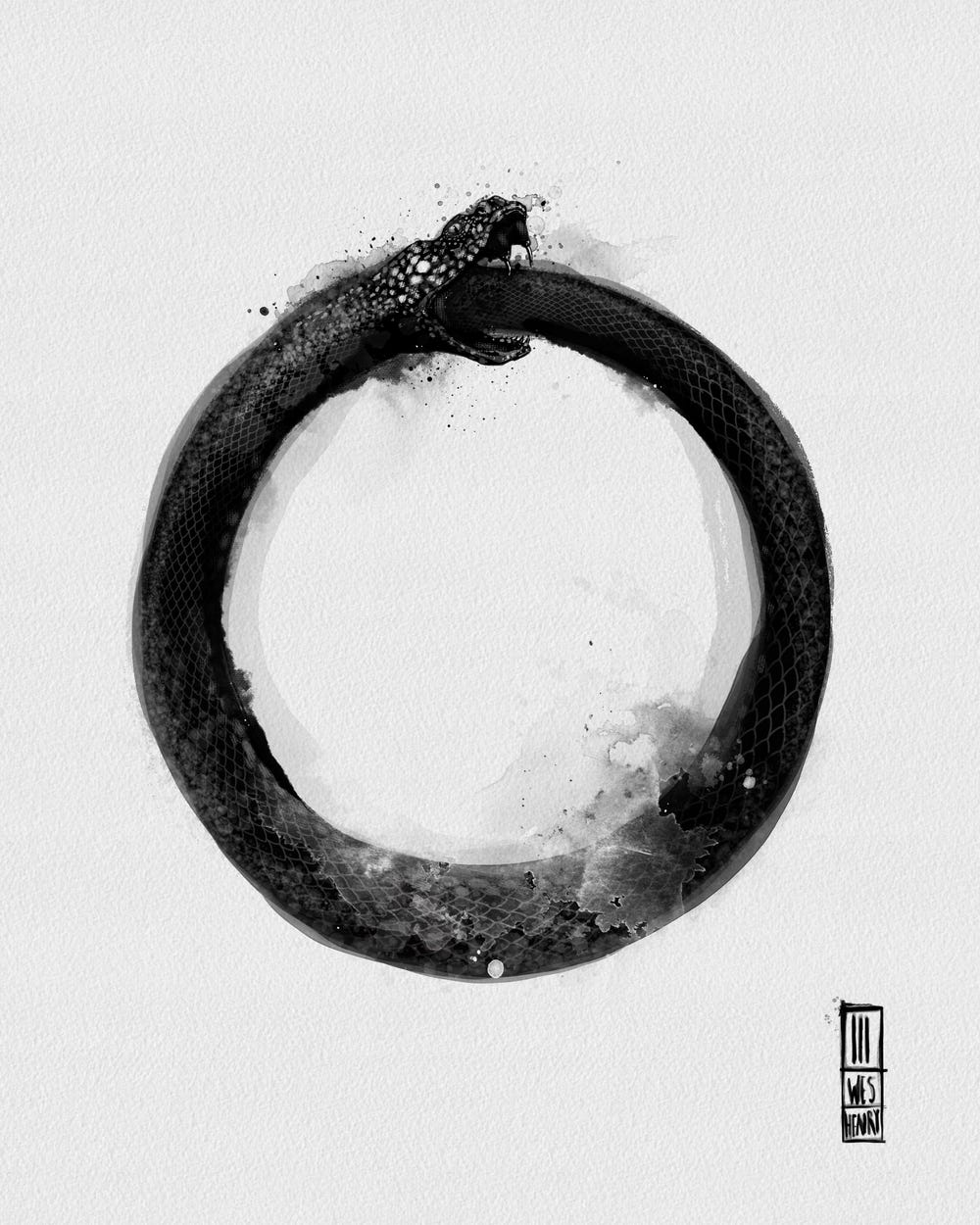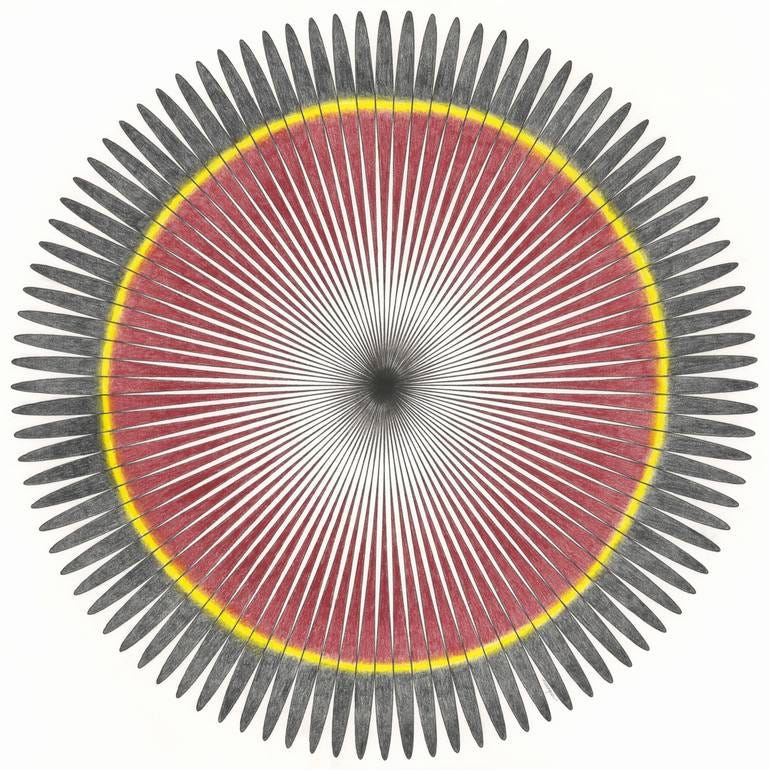Cycles
The beginning, if there ever could be such a thing, of exploring the interconnected cycles of life here on Earth and beyond.
This piece will serve as the beginning for a series on the various cycles we find in nature and the interdependent concentric circles that mirror one another throughout the known universe. Within these fractal-line depths, it is my hope that you will find echoes of your own human-ness, as much as how what you subjectively define as your human-ness may be universal. It is my belief that these cycles fundamentally connect us as they radiate out from the smallest particles to the vast reaches of the universe. After all, as you take in a breath of your environment causing an expansion of your lungs and as the exhalation contracts them, so the universe might expand and contract in unfathomable breaths itself. As your menstrual cycle waxes and wanes, so does the moon. As animals on this planet go through a life cycle, greater life cycles of the earth itself are underway, as if in slowing motion, and further out our sun goes through a life cycle all its own.
As Rumi said: You are not a drop in the ocean, but the ocean in a drop. We understand our connection to things only in so much as we can understand that we are those things and they are us. We are one in the same. We are a thread woven into this earth, into this universe, and when you pull on an individual thread, it tugs at the rest of the weaving (and maybe, it is only the illusion of individual threads, instead it might be just a single thread folded many times over). But perhaps, when you zoom out, you know that we’re not just threads but notes, each of us a plucked chord to a grand symphony we might be able to hear if only we listen closely. Maybe further out that echoes as a single note in yet another concentric circle that surrounds our universe.

Art by Wes Henry
Like the snake consuming its own tail; the ouroboros; a cycle is represented as a set of events or phenomena that recur in a sequence. Sometimes, they spiral outwards, a positive feedback loop amplifying the cycle like the contractions of a woman during childbirth. Other times, they cave inward, a negative feedback loop drawing the cycle tighter, like the relationship of insulin and blood sugar. Like a sine wave, we can find a living rhythm to the periodicity in nature’s cycles as they strive for a sense of homeostasis.
Just because the cycles feel independent from one another, we must acknowledge at the outset that they are not. They are connected to other cycles that exert their own cause and effect on one another by some force we can, at times, only imagine. It may be tempting to see the cycles as cogs within a machine, but I encourage you to think beyond those mechanistic and linear bounds and imagine instead, that they are cells within an organ, organs within a body, a body within an ecosystem, an ecosystem within a planet, within a solar system, within a galaxy, here in this universe. Like the film Powers of 10 in your 10th grade biology class, all these functions and biomes are nested within one another in an omnidirectional cascade of influence.
From the Ancient Greek kúklos and the latin cyclus, the word cycle derives from the word for circle or wheel. If we expand out from there and explore the definition of a circle, we’ll find Euclid expounding on its geometry:
“A circle is a plane figure bounded by one curved line, and such that all straight lines drawn from a certain point within it to the bounding line, are equal. The bounding line is called its circumference and the point, its center.”
You might imagine that throughout time, the recognition of a circle may have dawned on early man as he gazed into the eye of a lover at the most profoundly perfect pupil and iris as he looked through his own elegantly wrought circular windows to what lay outside himself. Perhaps he looked up and saw the fullness of the moon and wondered that it should be shaped in such a way at that moment, when at other times it was only a part of the whole instead of the whole itself. Maybe it was then he knew that the cycle of a moon could be drawn in the same shape it was at its apex of fullness and thought back to the areola of his lover, another perfect circle when pulled taut by the fullness of her desire, which would ebb and flow with her blood, at times in perfect rhythm with the moon. Yes, maybe it was then that early man dipped his finger in the blood of an animal he had just killed and drew on some rock, somewhere, the representation of the life that had come to an end and had become meat that would be transformed into his own flesh and blood, that would one day absorb back into the earth, just as this animal’s had. Maybe he alighted on these thoughts, one after the other, knowing somehow that they could not be teased from one another, or at the very least, ignorant that later iterations of man would have the hubris to even try. In that perfect circular moment, it was just the moon and lover, death into life and back again, wonder and desire all interconnected beyond reason and understanding.
It is important before we delve into the realms of attempting to reason and understand, that we first hold a space of awe. If we could rewind backwards to the continuity we might have once, and could again, experienced with our environments, like a cow chewing its cud, we might find that in the unknowing we can experience the transformative magic of connection. We can pause on the edge of wonder, as if poised on the precipice of the drop off the cliff of what it means to gaze at the inestimable improbability of the unknown.

Singularity by Mary Wagner
It is in the knowing, or the searching for the underlying mechanism, that we sometimes lose that sense of wonder. Like a curtain pulled to show you the pulleys and scaffolding behind the scenes of a play, we suddenly sense that there is more at work than we initially glimpsed. Look further and find that each pulley is comprised of nuts and bolts and rope and the scaffolding is composed of many pieces held together. And even those nuts and bolts, they were manufactured somewhere by some machine, or wrought by hand in some painstaking effort by tools that were once forged by that same effort, rendered from raw materials gathered from the earth where they had been mined out of the annals of deep time from a rock that was hurled forth from the singularity of the big bang. On second thought, perhaps if we go deep enough into the underlying mechanism, our wonder can return.
Notice now the circle of your own focus on these concepts as it zooms in with the precision of the lens of a camera, a machine modeled after the delicate aperture of your eye, on the smallest detail; a nut, a bolt and back out to the largesse of the beginning of time in a single dilation of thought. Your attention contracting to the words you’re reading and then expanding back outwards to your environment, the felt sense of the bounds of the space you’re in, the matter beneath your feet, the temperature of the air that surrounds you. Feel how you can orient yourself in space and time while your mind hurtles through the reaches of space and time, even as that inconceivable expanse we call the universe expands and contracts alongside your focus and your breath. Even your pupils at this moment are foveated and contracted in concentration and can be flung out as you pause to glance at the horizon and take in the panorama of your environs once again.
Expand and contract. Contract and expand. Pupils, lungs, universe. A breath in and a breath out.
If humans could be reduced to machines, then we would be machines of making meaning, and recognizing patterns and that would bring us back to our gnosis of the cycles we observe on this earth and the shape of a circle.
The Krebs cycle shaping the life cycle of a human at the cellular level, which then dovetails into the single life cycle of a human on earth, that will merge into the mineral cycle of soil as a body decays in a grave, the mineral cycle will fuel the life - from fungi to mammals - that help shape the water cycle, which in turn plays a role in shaping the deeper cycles of climate here on earth, which will have an effect on the life cycles of the life forms that inhabit it, and then back to the cycles of cells, beginning again with no start and no end. If cycles can be as intertwined as those, then surely some cycle here on earth is a part of what shapes the cycles of the cosmos.
These cycles will be explored through lenses of history and science but also through our own felt and embodied understanding, beyond the realms of science, and in the language of feeling. It is my hope that you will join me on this journey and exploration of finding our human-ness in others and the otherness in our own humanity.
Welcome to Cycles.
A Post Script: No doubt, along the way in all of this, I will make mistakes in prose and concept. There will be plenty of run on sentences, my specialty, as well as other grammatical foibles. It is my goal with this series to put this work into the world without concern of perfection, but with the goal of sharing a concept that has been bubbling inside me. I feel that through that exploration, I will find flaws in my own logic and understanding, and so will you. But I don’t want this to stop me from sharing.



